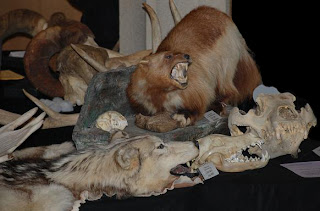Have you ever been to the Burke and wondered what's in the rest of the building? Behind the exhibits (actually, under them, around them, and above them!) are offices, the exhibit workshop, and enough cabinets full of wonder to make Indiana Jones jealous.
In this edition of Science Behind-the-Scenes, meet the Burke's mammal collection and find out why we keep drawers full of flattened animals and their bones!
 |
| Mammals on display at Meet the Mammals |
Mammalogy is the study of mammals (a mammal is an animal with a backbone that has hair and produces milk for its newborns). Over 5,400 species of mammals live on Earth today and many more species have lived and died since the time of the dinosaurs. That's right—running around the feet of Allosaurus and Stegosaurus were little furry mammals.
Fossil mammals can be found in the paleontology collection. Humans are mammals but anything to do with humans is usually found in the archaeology or ethnology collections. The mammalogy collection houses all the Burke's "recent" (non-fossilized) mammals—bones, skins, whole animals, flattened animals. Mammalogy has everything from exotic animal skins confiscated from smugglers to squirrel skeletons used by scientists to study local squirrel populations.
The Burke Museum's mammal collection has over 50,000 specimens (a specimen can be one animal or part of one animal). We've got everything from wolves to wolverines, bats and flying squirrels, tiny shrews and huge whales. You won't find many of these out on display because there's just not enough room! But you can see a lot of mammals during our annual Meet the Mammals event—and even touch a few.
Even though visitors don't get to see the mammalogy collection often, it's important and gets a lot of use from students and researchers. Collection manager Jeff Bradley keeps all the mammals clean, safe, organized, and available for research. He works with graduate students and volunteers to process new specimens (sometimes that means picking up a dead whale from the beach!) and keeps track of the old ones.
 |
| Wolverine bones laid out for study |
Graduate students and scientists from the University of Washington and elsewhere use the collection for research. Current research in the collection includes studying how mammals have responded to environment change in the past several million years. This could also tell us how humans have affected other mammal populations.
Paleontologists who study prehistoric mammals also use the mammalogy collection to figure out what extinct mammals may have been like, how they spread across continents, and how they evolved. Stay tuned for more behind-the-scenes news from the mammalogy collection and look for more Science Behind-the-Scenes at the Burke to learn about the bird, fish, and DNA collections!
Posted by: Winifred Kehl, Communications
Posted by: Winifred Kehl, Communications
